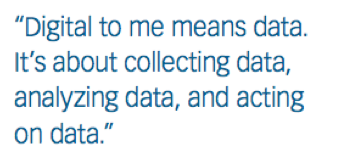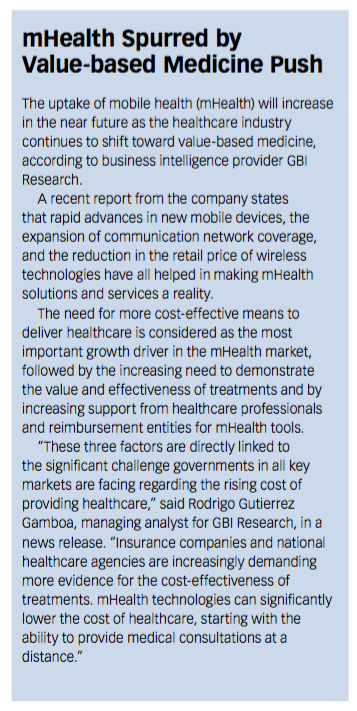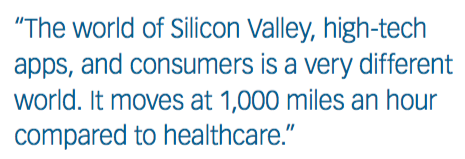Pharma Raises Stakes in Digital Health
The rapid development and take-up of digital technology is forever changing the way pharma engages with patients-but the industry’s ultimate potential in tapping digital health to transform patient care hinges on embracing new shifts in culture and business strategy.
Industry tries to keep pace with digital health: The rapid development and take-up of digital technology is forever changing the way pharma engages with patients-but the industry’s ultimate potential in tapping digital health to transform patient care hinges on embracing new shifts in culture and business strategy.
If a biopharmaceutical company is not convinced it should be investing in digital health, they should perhaps consider this simple but true reality: drugs can only do so much.
“There are so many issues that selling pills by themselves can’t solve because other factors are involved,” says Bradley Merrill Thompson, a partner at national healthcare law firm Epstein Becker Green. “The lack of patients taking medicine is a prime example. If pharma companies just make pills, they are going to hit a wall trying to change patient behavior.”
A recent review in the Annals of Internal Medicine backs up this assertion. The report finds that 50% of medications for chronic diseases are not taken as prescribed, and the severity of the disease doesn’t matter.
Earlier this year, The New York Times, in an article entitled “The Cost of Not Taking Your Medicine,” reported that lack of medicine adherence can cost the US healthcare system between $100 billion and $289 billion a year.
“Pharma companies want to get into the outcomes business,” Thompson told Pharm Exec. “They want to help make people healthier.”
Although a strong argument by itself, adherence is not the only reason, or way, drug manufacturers can invest in the digital health game. In special expanded coverage in the pages ahead, Pharm Exec examines the explosion and increased adoption of digital health in the life sciences from several angles, including business impact, patient adherence, infrastructure, and high-tech innovations at the product level. The digital revolution may have pushed itself into the medical world slower than other industries, by there is little doubt now of its rising influence in driving the future of healthcare.
Defining digital health
Ask 10 people for their definition of digital health and you will likely get 10 different answers.
“Social media.”
“Software for sales.”
“Electronic health records.”
Answering the not-so-simple question of what is digital health as it relates to pharma can be a bit complicated.
At first, many people automatically think of social networking sites like Twitter and Facebook, or some type of app. But, that is not always the case. Digital health strategies can extend into all aspects of a pharma company’s structure-from sales and marketing, to R&D and business-to-business activities.
“Digital health means something different to everyone,” says Nicole Mowad-Nassar, vice president and lead, US business operations and external partnerships, at Takeda Pharmaceuticals. “Some say wearables, some say it’s apps. Digital to me means data. It’s about collecting data, analyzing data, and acting on data.”
Two years ago, Mowad-Nassar’s company launched the Takeda Digital Accelerator, an incubator inside the organization that also works with various partners, including those outside the world of pharma.

The idea came about as a way to make it easier to learn about “digital” and try digital experiments within the company.
Such efforts also illustrate the need for pharma companies to have diversified digital portfolios. Takeda, for instance, has implemented a digital sales platform to make it easier on their sales reps. When calling on a physician, they can simply pull up data such as their referral patterns, affiliations, and publications.
While the tools helps the sales reps in the field, it also benefits the work of those back in the office. “It helped us to be smarter at marketing and in customer exchanges by allowing us to know our customers more
Sidebar: mHealth's 'Value' Driver; click to enlarge

intimately,” says Mowad-Nassar.
Tapping and engaging the patient community may be considered the most important digital market priority for life sciences organizations. Earlier this year, Takeda and Cognition Kit Limited, a joint venture between Cambridge Cognition Holdings PLC and Ctrl Group Limited, announced a collaboration to pilot the use of a specially designed app on the Apple Watch to monitor and assess cognitive function in patients with major depressive disorder (MDD).
The study involved 30 participants, ages 18–65, with a clinical diagnosis of mild-to-moderate depression who have been prescribed an antidepressant for MDD. The goal was to evaluate feasibility and compliance, and to understand how measures of mood and cognition on wearable technology compare to more traditional neuropsychological testing and patient reported assessments.
“This collaboration is part of our strategy to embrace new technology to better understand the patient experience and assist healthcare professionals in creating improved patient care pathways,” Mowad-Nassar said in a press release.
Regulatory worries
Whenever the topic of digital health gets brought up, a mention of the FDA is usually not far behind. Pharma companies tend to tread lightly around the idea of digital health, not just because there is a lot of uncertainty around the concept, but also because there is even more ambiguity when it comes to digital health regulations.
Companies are worried that they might overstep into uncharted territory. Experts, however, believe this is a very good time for pharma organizations to think hard about digital health in their business planning.
“People at the FDA are excited about digital health, and don’t want to overregulate it,” says Thompson. “In fact, there are a number of initiatives to try and pull back some of the regulations.”
For example, in the 21st Century Cures Act, passed by Congress in December 2016, the legislation excluded from FDA regulation certain clinical decision support software.
The agency is also inching closer to the creation of its own dedicated digital health unit, to be housed within its Center of Devices and Radiological Health (CDRH) division. Established as part of the next steps of the Medical Device User Fee Amendments Act, the center will be creating 13 new full-time positions focused on digital health.
According to the FDA, the unit-among other things-will develop software and digital health technical expertise to provide assistance for premarket submissions that include software as a medical device (SaMD), software inside of medical devices (SiMD), interoperable devices, or otherwise incorporate digital health technologies. The unit will leverage technical experts as appropriate, or when requested by drug manufacturers for submissions that include those three elements. Another focus will be the incorporation of appropriate metrics for digital health improvements to monitor, track, analyze, and report the results of digital health premarket review timelines.
The FDA unit will participate in international harmonization efforts related to digital health, including work on developing SaMD and other digital health convergence efforts through the International Medical Device Regulators Forum.
Digital culture shift
There is much talk and attention in the industry concerning digital health, but not always a lot of action. To that end, identifying what makes a company move away from digital pharma lip service and take action is useful. Experts attribute it to the shift in thinking by leadership at certain organizations.
“We see it succeed when it becomes C-suite imperative,” says Kenneth R. Munie, managing director, Accenture Strategy. “The notion of spreading digital across P&L (profit and loss) structure around brand is not going to get big digital innovations. Instead, make it C-suite imperative, and then fund it and manage it appropriately.”
Ingraining that culture and mindset into pharma management teams is no small task, however. Succeeding in the digital health arena requires a different skill set than doing so in the traditional pharma and healthcare settings.
“It’s a challenge for the industry,” Pete Masloski, a principal at ZS Associates, told Pharm Exec. “One of these [challenges] is that it’s a different world than pharma. The world of Silicon Valley, high-tech apps, and consumers is a very different world. It moves at 1,000 miles an hour compared to healthcare. It’s a different culture.”
According to Masloski, many companies operate some type of separate organization internally that deals solely with digital health. For example, Bayer created a team to be a liaison of sorts to Silicon Valley in efforts to remain updated on the latest digital health initiatives in the tech world.
According to MedCity News, the Bayer group investigates ways technology can benefit the larger organization in all areas of its business-from marketing and manufacturing to research and supply chain.
Although the tech and pharma industries don’t fundamentally mesh very well, experts say both need each other and could benefit strongly from closer synergies. Masloski pointed out that pharma companies possess the capital and healthcare experience that the digital health start-ups don’t have. Conversely, digital health-focused

companies are nimble and have the ability to quickly create solutions in the ever-changing digital world.
But opposites do attract, and as Masloski explains, the two sectors can work together. To be successful, however, in cultivating those relationships starts with good planning.
“Have a clear investment thesis,” says Masloski. “Which is basically, ‘what is it our company is really trying to accomplish by getting into this digital world?’ Having a clear investment thesis can help screen out investments, while simultaneously help to figure out how to invest in the right places to align the organization [for digital success].”
Recognizing the differences required to be successful in this space is also critical, Masloski notes. One of the current challenges, he explained, is that pharma leaders need to be prepared to learn about and evaluate on a different set of metrics than they are accustomed to.
Not business as usual
As millennials graduate medical school and take control of the prescription pad, the way this segment of society deals with pharma companies will also shift.
“Our job is to look beyond life sciences,” says Arno Sosa, vice president of product strategy for Veeva Systems, during a media roundtable at the company’s annual summit earlier this year in Philadelphia.
Looking beyond life sciences means researching how other industries have been disrupted by digital media, and learn from those experiences.
The new generation of healthcare leaders-from future CEOs and salespeople to physicians and nurses-are accustomed to being engaged on digital platforms. For pharmaceutical companies, therefore, there is going to be an expectation for a certain level of digital engagement with these communities, and with some consistency, says Stephen Davies, an analyst with Gartner.
For example, instead of signing on to multiple websites to get drug information, future healthcare providers are going to want some type of standardization. Will that mean a single healthcare portal where a doctor can sign in once and access all the drug information for every pharmaceutical company? Perhaps.
Although Davies doubts the industry will get to that point, working together to make it easier to digitally access information must be a top priority, especially given that access to physicians by pharma brand teams is becoming more restricted.
Experts note that if someone inside the industry doesn’t create the solutions that customers and this new generation of physicians and customers want, someone from outside the industry, like a Google or Amazon, will have the opportunity to enter the space and truly change the way business is conducted. This can also be applied to the way pharma organizations provide other services.
Take Teva’s active pharmaceutical ingredients (API) manufacturing arm, TAPI, for example. The TAPI Online customer portal is a key touchpoint for customers-it’s a digital service platform, an information and communications hub for TAPI customers and representatives.
“TAPI Online is a customer-centric portal that delivers immediate access to the information and tools our customers need to manage day-to-day API-related work so that they can collaborate with us and their team members to keep projects on track and moving forward,” says Kerri McCullough Wood, senior vice president, TAPI commercial.
TAPI Online creates a more streamlined communication exchange around specific projects, replacing the cumbersome and disjointed email communication process with a submit-and-track service request interface, adds Wood. Customers can track progress and status of their projects and orders all in one place and have immediate access to thousands of API-related documents they can “self-serve” and download instantly once logged in to the platform.
Beyond the pill
The emergence of digital services such as these is illustrative of the changing business and engagement models for pharma companies.“Simply providing pills is only one piece of the picture,” Masloski told Pharm Exec. Nowhere is that apparent more than in pharma’s responsibilities and involvement in the patient experience.
Masloski’s assessment that the pharma industry has a hard time actually understanding the patient, their situation, and experience with a disease or drug is not new. Investing in digital health to learn more about the people who are taking a company’s therapy is a smart solution to this problem.
“It’s a way to get more insight into what’s going on with the patients,” said Masloski.
Mowad-Nassar agrees.
“Digital allows us to get much closer [to the patient] and understand their journey,” she says. “It can help us improve the dialogue and do it in a responsible way and become a trusted resource for the patient by
providing more than just a pill.”
Getting closer to the patient experience is something that Eric Peacock, CEO of MyHealthTeams, knows a lot about. His company builds social networks for people living with chronic conditions such as multiple sclerosis, Parkinson’s disease, diabetes, HIV, and more, totaling about 24 communities and bringing together

more than one million active members.
Translated into pharma speak, that’s a lot of data-data that can be very valuable to drug companies who want to know what their target customer is thinking, experiencing, and doing.
Peacock works closely with pharma organizations, gathering data and patient feedback, to help those in the communities get their experiences and concerns across to the manufacturers-a win-win for both sides.
For example, Peacock cited one condition where the data showed that while the medication was treating a specific chronic condition perfectly fine, there were second, third, and fourth issues making dealing with their condition a problem.
The pharma company they worked with learned about these secondary effects and was able to help their customers address them-problems the companies previously didn’t know existed if not for this community.
Social networking problems
Although a pharma company may not be actively participating in digital media channels, patients are. In fact, they are likely talking about a drugmaker somewhere, someplace at this very moment. Some of it might be good, some of it might be bad.
This is an especially sensitive subject when it comes to clinical trials. During the DIA Annual Meeting last month, Lindsay McNair, chief medical officer at WIRB-Copernicus Group, explained that patients want to discuss their experiences-and sometimes that’s not necessarily a good thing.
She shared stories of patients who used social media and digital forums to talk about everything from the taste and smell of a pill to the size and color in an effort to find out if they were taking a drug or a placebo. Although innocent, sharing sensitive information like this, or side effects and other experiences, can compromise a trial.
This is where pharma companies should invest in digital health communities, in which patients can safely share their experiences in a controlled environment, and where moderators can keep an eye on the conversation and hear what people are saying.
Although it may not stop patients from divulging compromising information completely, educating them and providing them a place to share their experience and connect with others going through the same process can cut down the risk.
Michelle Maskaly is Pharm Exec’s Senior Editor. She can be reached at michelle.maskaly@ubm.com and on Twitter at @mmaskaly

Is Artificial Intelligence a ‘Product’? Products Liability Implications for AI-Based Products
April 10th 2025As the physical products we use evolve to become increasingly complex, traditional products liability frameworks may not always fit to provide remedies for harm that can result from using novel product types.